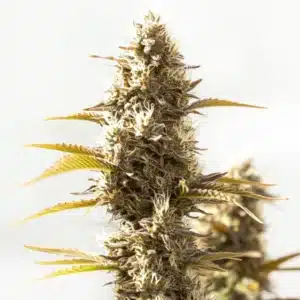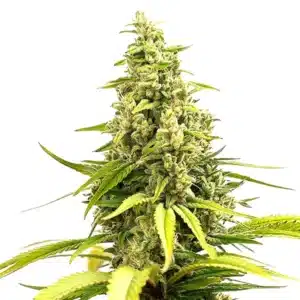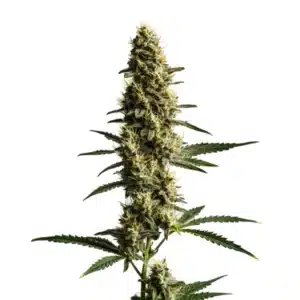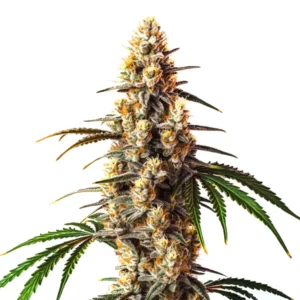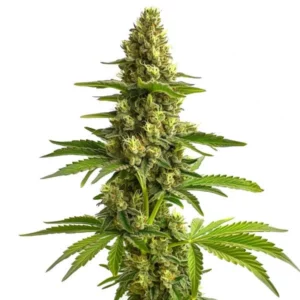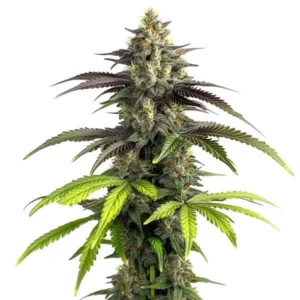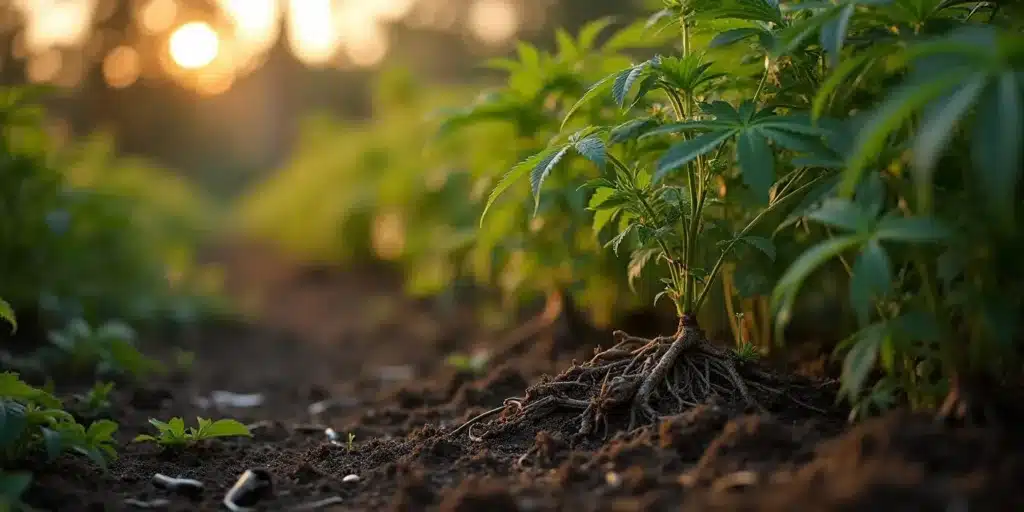
Necrosis Cannabis Roots
Necrosis in cannabis root systems can be a daunting challenge. This condition, where parts of the root die off, can severely impact the health of your cannabis plants. Unlike above-ground issues, root problems often go unnoticed until they become severe. Early detection can save your crop from disaster.
Root necrosis in cannabis plants often results from factors like overwatering, nutrient imbalances, and poor soil conditions. When roots begin to die, they lose their ability to absorb nutrients and water effectively, leading to stunted growth and yellowing leaves.
Recommended Strains
Godfather OG
|
|
THC | 26% - 30% (High) |
|
|
Type | Feminized |
|
|
Yield | High |
|
|
Phenotype | 60% Indica / 40% Sativa |
Godfather OG Auto
|
|
THC | 25% - 26% (High) |
|
|
Type | Autoflowering |
|
|
Yield | Low |
|
|
Phenotype | 70% Indica / 30% Sativa |
Identifying Necrosis in Cannabis Roots
Spotting necrosis in cannabis roots requires a keen eye. The first signs often appear above ground as yellowing or wilting leaves. If you dig a little deeper, affected roots may look brown, slimy, or even smell foul. Healthy roots, on the other hand, are white and firm.
A closer inspection is sometimes necessary. For larger plants, a good method is to let the soil dry out completely, which allows you to gently slide the entire root ball out of the pot for a full inspection. For smaller plants or seedlings, a less invasive technique is to use a pen or a small stick to carefully lift a small section of the soil to inspect the shallow roots or check on a germinating seed. If you notice any dead or dying roots, it’s time to act.
Causes of Necrosis in Cannabis Plants
The causes of necrosis are often linked to environmental factors. Overwatering is a common culprit, as it suffocates the roots.
Nutrient imbalances can also lead to necrosis. Cannabis plants require a balanced diet. Using a quality nutrient solution and monitoring pH levels can help prevent these issues. In particular, a very low pH (below 4.0) can make the water so acidic that it directly causes necrosis in the roots.
Environmental stressors like extreme temperatures can also contribute. An excess of heat in the root zone or direct light exposure on the roots can also cause necrosis. It is vital to protect bare roots from light, especially during transplanting or when a seed’s first radicle has just emerged. In addition to environmental factors, pest infestations like root aphids or fungus gnats can damage roots.
Promos & Deals
Preventing Necrosis in Cannabis Root Systems
Cannabis root necrosis prevention methods are vital. Start by choosing the right growing medium. A well-draining soil mix will prevent waterlogging.
Another effective prevention method is maintaining proper nutrient balance and pH. It is fundamental to start with a soil that has an initial pH between 6.0 and 7.0. You should also consistently aim to water with a pH of 6.0 to maintain this balance.
Applying a layer of mulch is another highly effective preventative measure. Mulch protects the plant’s main root system from temperature extremes and moisture loss, meaning you’ll need to water less and the roots will be less stressed.
Implementing a routine inspection schedule is another key aspect. Incorporating organic amendments, such as mycorrhizal fungi, can also enhance root systems’ resilience.
Implementing a Preventive Approach
Prevention is always better than cure. Maintain a consistent watering schedule and avoid overwatering. Let the top inch of soil dry out before watering again. Consider using strains resistant to root-related issues, like the Tangie strain from Blimburn Seeds.
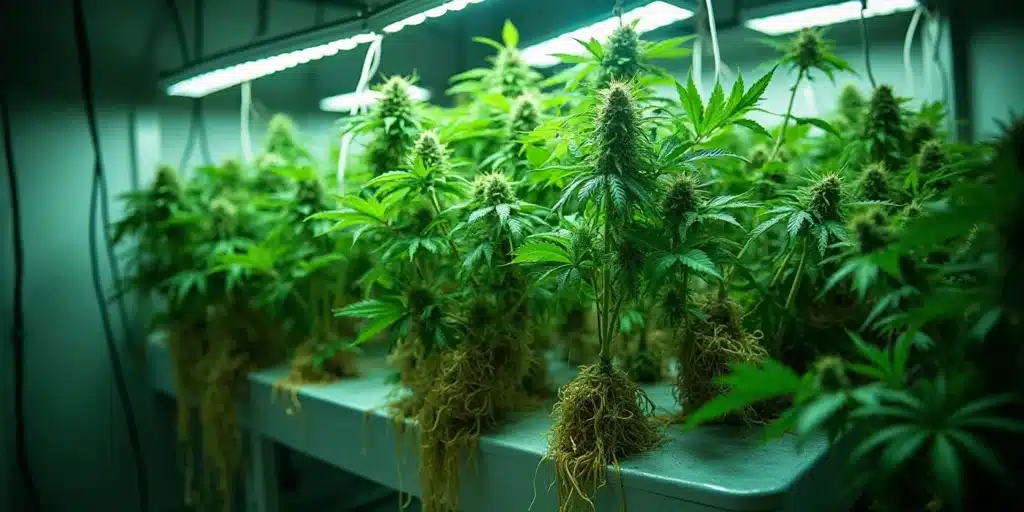
Real-Life Examples and Practical Tips
Real-life experiences offer invaluable lessons. Take the example of a grower who noticed stunted growth due to overwatering. By adjusting their watering schedule and improving drainage, they revived their plants. Another grower faced nutrient-related necrosis and restored their plants’ health by switching to a balanced nutrient solution and monitoring pH.
As a specific treatment, if you detect a bad color or the beginnings of rot in the roots, some growers recommend a corrective flush. Watering the plant with a solution pH-adjusted to be slightly more acidic, around 5.5, can help make the root zone less hospitable to certain pathogens and can help correct nutrient lockout issues.
Strains to Consider for Healthier Roots
Choosing the right strain can make all the difference. Consider the Zombie Death Fuck strain from Blimburn Seeds. It’s known for its resilience and strong roots. Experiment with different growing techniques to find what works best for your plants.
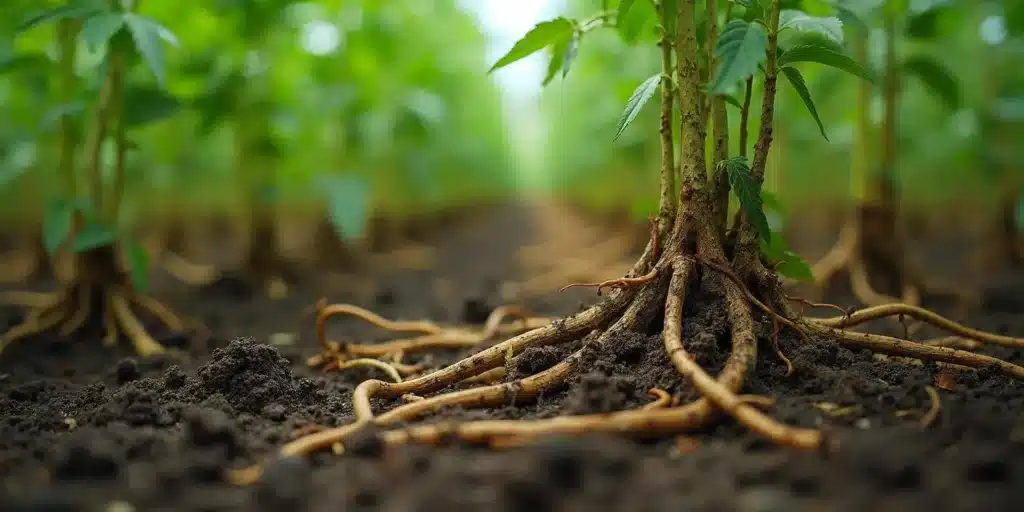
FAQs
What causes necrosis in cannabis roots?
Necrosis in cannabis roots often results from overwatering, nutrient imbalances, and poor soil conditions. Excess moisture suffocates the roots, leading to rot and decay. Additionally, a lack of essential nutrients can stress the roots, making them more susceptible to necrosis.
Environmental factors, such as temperature and humidity, also play a role. High humidity levels can promote fungal growth, which attacks the roots. Maintaining a balanced environment is crucial for preventing necrosis and ensuring your cannabis plants thrive.
Poor air circulation around the roots can further increase the risk of necrosis cannabis roots. Ensuring proper ventilation and airflow around your growing space can help mitigate these risks, promoting a healthier root environment.
In some cases, genetic predispositions can influence how susceptible a plant is to root necrosis. Selecting strains known for robust root health can be a preventative measure against necrosis in cannabis root systems.
How can I identify necrosis in my cannabis plants?
Identifying necrosis in cannabis plants involves observing both the above-ground and below-ground parts. Look for yellowing or wilting leaves, which are often the first signs. Dig deeper to inspect the roots; necrotic roots may appear brown, slimy, or emit a foul odor.
Regular monitoring is key to early detection. Check your plants frequently and take action at the first sign of distress. By maintaining vigilance, you can prevent minor issues from escalating into severe problems.
Utilizing diagnostic tools, such as soil moisture meters and pH testers, can aid in identifying necrosis cannabis roots. These tools provide quantitative data, helping you make informed decisions about plant care and addressing root issues.
Incorporating visual aids, like photographs or diagrams of healthy versus necrotic roots, can also help you distinguish between normal and problematic root conditions. This knowledge is essential for effective cannabis root health and necrosis management.
What are effective prevention methods for root necrosis?
Preventing root necrosis involves several proactive measures. Ensure proper drainage in your pots and avoid overwatering. Use a well-aerated soil mix to promote healthy root growth. Maintaining a balanced nutrient regimen and stable pH levels also helps prevent necrosis.
Choose resilient strains like Tangie or Bruce Banner 3 from Blimburn Seeds. These varieties are known for their strong root systems and ability to withstand stress. By selecting the right strains and employing preventive techniques, you can safeguard your cannabis plants from necrosis.
Incorporating beneficial microorganisms, such as rhizobacteria, into your growing medium can enhance root health and resilience. These microorganisms support nutrient uptake and protect against pathogens that cause necrosis cannabis roots.
Regularly rotating your crop and using clean, sterilized equipment can reduce the likelihood of root necrosis. These practices help prevent the buildup of harmful pathogens in the soil, contributing to a healthier growing environment.
Why is cannabis root health important?
Cannabis root health is vital for overall plant growth and productivity. Healthy roots absorb nutrients and water efficiently, supporting robust growth and high yields. Without healthy roots, plants can’t access the resources they need to thrive.
Root health also impacts a plant’s ability to resist diseases and pests. Strong roots can better withstand environmental stressors and recover more quickly from damage. Prioritizing root health ensures your plants remain vigorous and productive.
Healthy roots contribute to the plant’s structural stability, allowing for more substantial growth and development. This stability is crucial for supporting the plant’s weight, especially during the flowering stage when buds are heaviest.
In addition to supporting physical growth, robust roots aid in the synthesis of secondary metabolites, which enhance aroma, flavor, and medicinal properties. Ensuring cannabis root health and necrosis prevention is essential for maximizing plant potential and quality.
Can I revive plants affected by root necrosis?
Reviving plants affected by root necrosis is possible with prompt action. Begin by addressing the underlying cause, such as overwatering or nutrient imbalances. Improve drainage, adjust your watering schedule, and ensure a balanced nutrient regimen.
Trim away any dead or decaying roots to prevent further spread of necrosis. With proper care and attention, many plants can recover and return to healthy growth. Remember, early intervention is crucial for successful recovery.
Applying root stimulants or growth hormones can accelerate the recovery process, encouraging new root development and enhancing overall plant health. These products can be particularly effective in reviving plants affected by necrosis cannabis roots.
It’s also beneficial to quarantine affected plants to prevent the spread of necrosis in cannabis root systems. By isolating and closely monitoring these plants, you can ensure they receive the care needed to recover without risking the health of your entire crop.




